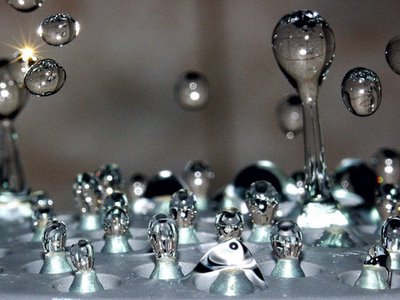
Dean Kamen is a very clever, very rich inventor and entrepreneur. While still a college undergraduate, he invented the first wearable infusion pump. In 1976 he founded his first medical device company to manufacture and market the pumps. At age 30, he sold that company to Baxter International Corporation for enough money to mean he never had to work again. Recently his Segway personal transportation device has gained a lot of headlines, if not much commercial success.
Dean Kamen has recently been focussing on two of the biggest issues facing humans on this planet, the estimated 1.1 billion people in the world who don't have access to clean drinking water, and the estimated 1.6 billion don't have electricity.
The following text is a (precised) version of an article published by CNNMoney.com
"Eighty percent of all the diseases you could name would be wiped out if you just gave people clean water," says Kamen. "The water purifier I've designed produces 1,000 litres of clean water a day, and it doesn't care what goes into it. And the power generator makes a kilowatt off of anything that burns."
Kamen has been joined by Iqbal Quadir, the founder of Grameen Phone, the largest cell phone company in Bangladesh. Last year, Quadir took prototypes of Kamen's power machines to two villages in his home country for a six-month field trial. That trial, which ended last September, sold Quadir on the technology.
So much so in fact that Quadir's startup, Emergence Energy, is negotiating with Kamen's Deka Research and Development to license the technology. Quadir then hopes to raise $30 million in venture capital to start producing the power machines.
The electric generator is powered by an easily-obtained local fuel: cow dung. Each machine continuously outputs a kilowatt of electricity. That may not sound like much, but it is enough to light 70 energy-efficient bulbs. As Kamen puts it, "If you judiciously use a kilowatt, each villager can have a night time."
The real invention here, though, may be the economic model that Kamen and Quadir hope to use to distribute the machines. It is fashioned after Grameen Phone's business, where village entrepreneurs (mostly women) are given micro-loans to purchase a cell phone and service. The women, in turn, charge other villagers to make calls. "We have 200,000 rural entrepreneurs who are selling telephone services in their communities," notes Quadir. "The vision is to replicate that with electricity."
During the test in Bangladesh, Kamen's Stirling machines created three entrepreneurs in each village: one to run the machine and sell the electricity, one to collect dung from local farmers and sell it to the first entrepreneur, and a third to lease out light bulbs (and presumably, in the future, other appliances) to the villagers.
Kamen thinks the same approach can work with his water-cleaning machine, which he calls the Slingshot. While the Slingshot wasn't part of Quadir's trial in Bangladesh, Kamen thinks it can be distributed the same way. "In the 21st century, water will be delivered by an entrepreneur," he predicts.
The Slingshot works by taking in water-based liquid - even raw sewage - and separating out the clean water by vaporizing it. It then shoots the remaining sludge back out a plastic tube. Kamen thinks it could be paired with the power machine and run off the other machine's waste heat.
Compared to building big power and water plants, Kamen's approach has the virtue of simplicity. He even created an instruction sheet to go with each Slingshot. It contains one step: Just add water, any water. "Not required are engineers, pipelines, epidemiologists, or microbiologists," says Kamen. "You don't need any -ologists. You don't need any building permits, bribery, or bureaucracies."
Kamen's goal is to produce machines that cost $1,000 to $2,000 each. That's a far cry from the $100,000 that each hand-machined prototype cost to build. Quadir is going to try and see if the machines can be produced economically by a factory in Bangladesh. If the numbers work out, not only does he think that distributing them in a decentralized fashion will be good business - he also thinks it will be good public policy. Instead of putting up a 500-megawatt power plant in a developing country, he argues, it would be much better to place 500,000 one-kilowatt power plants in villages all over the place, because then you would create 500,000 entrepreneurs.
Fascinating fact to throw into a lagging conversation: Dean Kamen's father is Jack Kamen, the illustrator of Weird Science and other EC Comics.
------------

No comments:
Post a Comment